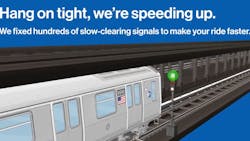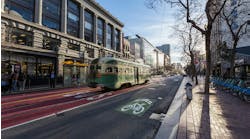MTA New York City Transit made significant subway speed improvements during pandemic
A series of encouraging updates about the success of ongoing efforts to safely speed up trains throughout the system was unveiled by the Metropolitan Transportation Authority (MTA) New York City Transit (NYCT).
This includes the installation of 919 new digital timers on grade time signals, 270 civil speed increases across the system over the past two years and a reduction in time trains spend holding at station platforms. The work builds on recommendations made in the “MTA NYCT Subway Speed and Capacity Review, Phase 2 Report," which was commissioned as part of the Speed and Safety Task Force launched by New York Gov. Andrew M. Cuomo in July of 2019.
Aging and faulty grade time signals and excessive time spent holding at station platforms were among the biggest factors that led to slower train speeds and comparatively poor on-time performance in the subway system prior to the creation of a dedicated SPEED Team in 2018. Despite the pandemic, NYCT remained focused on safely increasing speeds and achieved several key accomplishments in 2020, which are expected to result in reduced running times for customers as they return to the system.
Key 2020 accomplishments:
- Transit employees methodically took advantage of lower ridership during the pandemic to accelerate installation of new digital timers on grade time (GT) signals, which control the speed of subway trains – completing 900 by October 2020 (ahead of schedule) and 919 to date.
- In 2020 alone, NYCT fixed 156 slow-clearing grade timers with an additional 14 completed in 2021.
- To date, 485 slow-clearing signals have been found throughout the system, with 413 of those having been resolved.
- Transit has identified 663 speed limits that could potentially be raised and 581 of those locations have been evaluated by members of NYCT’s safety and engineering teams. Of the speed limits evaluated, 279 of those have already been updated in the field, including 65 civil speed restrictions raised in 2020.
"We've continued to identify root causes for slower speeds, and we've continued to move rapidly to fix grade time signals that were defective and to increase speeds where it’s safe to do so," said Interim New York City Transit President Sarah Feinberg. "But make no mistake, this is not the end. We will continue to inspect the system so that as new speed-related challenges emerge, we are prepared to address them promptly. We can't return to an era when these things weren't being effectively monitored – that's not fair to our customers or our train operators, who need to be confident they can travel at the maximum safe speeds possible when moving our millions of customers. My thanks to train and speed safety task force chair Jane Garvey, TWU Local 100 President Tony Utano, former FRA Chief Safety Officer Bob Lauby, and the men and women of NYC Transit for helping us to accomplish these goals."
Members of the dedicated SPEED Team have continued to work closely with employees in several divisions within the Department of Subways to check on the reliability of grade time signals so that train operators are able to move customers at the maximum safe speed possible throughout the system. The dedicated unit has also traveled the system to identify parts of the system where previous speed limits can be safely increased.
Many locations had speeds doubled or increased significantly. Some examples include changing the northbound curve entering City Hall on the R Subway and W Subway from 6 m.p.h. to 15 m.p.h., changing the southbound speed limit at President Street on the 2 Subway and 5 Subway from 15 to 35 m.p.h., changing the speeds on the express tracks on Queens Blvd. from 35 to 50 m.p.h. at multiple locations, and removing the 25 m.p.h. limit on the D Subway line express in the Bronx, allowing for speeds about 40 m.p.h. near Fordham Rd and Kingsbridge Rd.
STV’s Phase Two report delivered in December 2020 verified that an increased speed on curves – labeled as ‘v6’ to denote a normal increased operating speed or “Comfort Level Speed” – is both safe and comfortable for customers (based on comprehensive testing and a balanced sample of riders). The report also estimates that running times could be reduced by a median of five minutes and 30 seconds on lines if grade time signals are working correctly and train operators drive the full speed limit and offers a set of recommendations for sustaining and continuing the progress on speeds that we have achieved to date.
History of speed limits and timer signals
Most of the NYC subway system was built between 60 and 116 years ago and early on in its existence, in order to provide for safe operations, various measures were put in place to ensure that trains were not going faster than the conditions they could handle. These measures ensure sufficient stopping distance for the braking capacity to a train ahead. They also provide for safe operation at switching points, on curves and grades and when approaching a train stopped in a station.
One simple measure was placing “civil speed restrictions” – essentially just speed limits and signs, just like the ones drivers see on highways and roads – at various locations that require reduced speeds throughout the system. The speed limits were designed to consider the operating characteristics of the trains that were in service at the time as well as track grades and curves.
Another measure involved the use of “grade time signals” or “timer signals” – signals connected to timing devices set to trip a train’s emergency brakes if the train passes at a higher speed than allowed. This fail-safe system ensures safety by stopping a train if it goes too fast at a fixed point.
Over the decades, car design and track geometry have improved, allowing cars to maintain stability and safe operation at higher speeds, but the speed limits were not always changed to reflect these advancements in safety and comfort. Meanwhile, timer signals continued to be installed throughout the subway system, with an uptick after two fatal crashes in the 1990s – one at Union Square on the Lexington Avenue Line (4, 5, 6) and one on the Williamsburg Bridge on the Jamaica Line (J, M, Z). Eventually, the number of timer signals grew to approximately 2,000 system wide.
Over time, a number of these signals became overly restrictive. Over time, both safety measures – which have been extremely effective at their intended goal of preventing accidents – had the unintended consequence of slowing some trips and causing delays by forcing trains to go much slower than allowed.



